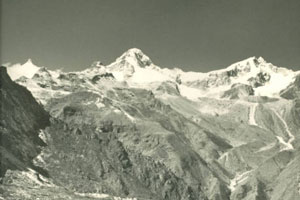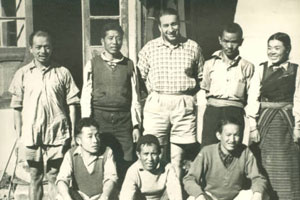The Collection
These photographs were taken by my father during the course of two trekking expeditions, one into the Northern Sikkim/Nepal region of India in 1952, and the other to the Kangchenjunga region of Nepal in 1954. An earlier expedition to Sikkim in 1949/1950 is recorded on 16mm film.
The first expedition to Sikkim was undertaken with Trevor Braham, who was an early member of the Himalayan Club and later the editor of The Himalayan Journal in the late 1950s. My father and Trevor Braham were fortunate in obtaining the services of the noted sherpa, Ang Tharkay, who put together a fine team of sherpas in Gangtok. My father also brought along a pair of skis. The expedition started out in November, 1949; they trekked towards the Sebo La pass via Changtang and Lachung and Yumtang. My father was unfortunately affected by altitude sickness but the prospect of skiing kept him going. He finally got his opportunity to ski on the Khangkyong plateau and glacier region.

Panorama view from Jannu glacier showing unnamed peaks
Here is an extract from Himalayan Odyssey (1974) by Trevor Braham (page 56). “From the pass the slopes fell away gently to the west, assuring us of a straight forward descent and enabling Hruska at last to put on his skis. As he glided smoothly, noiselessly down the the long slopes, the sherpa’s reaction was first one of amusement then of envy. There were superb views to the south-west of Chombu and Kangchenjunga”. My father noted that on this expedition, they saw numerous unidentified glaciers and mountain peaks. He eventually curtailed his participation in the expedition and returned to Gangtok because of his altitude sickness.
While the use of skis was unusual, he was not the first to ski on elevated plateaus and Himalayan glaciers. As early as the 1920s, probably earlier, there was a Ski Club of India in Gulmarg, Kashmir; later during the British ascent of Kamet 7755m in 1931, one of the expedition members used skis up to a col at 7162m. Kamet is the second highest mountain in the Garwhal region, 250 kms northeast of the city of Delhi just west of the point where Tibet, Nepal and India meet, namely at the western end of the Himalayas. My father’s 1949/1950 expedition may have marked one of the first attempts to ski in the eastern Himalayan range.

M. Hruska Trekking Sherpa/Sherpani team. Team composed of 6 sherpas and 2 sherpanis (Dikki & Dachu)
These expeditions were in many ways unique, not from any peaks scaled, but from what they achieved. In 1949/1950, 1952 and 1954, various parts of Northern Sikkim and the Nepal Kangchenjunga region were not well known. The maps of the day contained huge gaps captioned with the words “Uncharted area,” or with graphical clouds labelled “Number of peaks uncertain”. Hruska often told his family that his films and photographs helped complete knowledge of the region for cartographers.
On his 1952 expedition to Northern Sikkim/Nepal, my father hired two female sherpanis, Dikki and Dachu. Women sherpanis sometimes acted as porters on trekking expeditions and performed equally well as their menfolk. He later observed that he never regretted the decision: the sherpanis carried the same loads as the men, but brought other skills, namely the ability to repair clothing and shoes, manage the cooking, and select and bargain more effectively for food from Tibetan yak herders. And as an aside he mentioned “And they never complained like the other sherpas did”.
The photographic record of the 1952 and 1954 expeditions was made with a Zeiss Ikon Super Ikonta photo camera and a 16mm Paillard Bolex movie camera. My father’s photographs and films helped other trekkers, expeditions and adventurers. The photographic record of the 1954 Kangchenjunga expedition, in particular, was of great assistance to many Himalayan Club and foreign climbers who were in the process of planning their own expeditions to the region of Kangchenjunga (the third highest mountain in the world).
